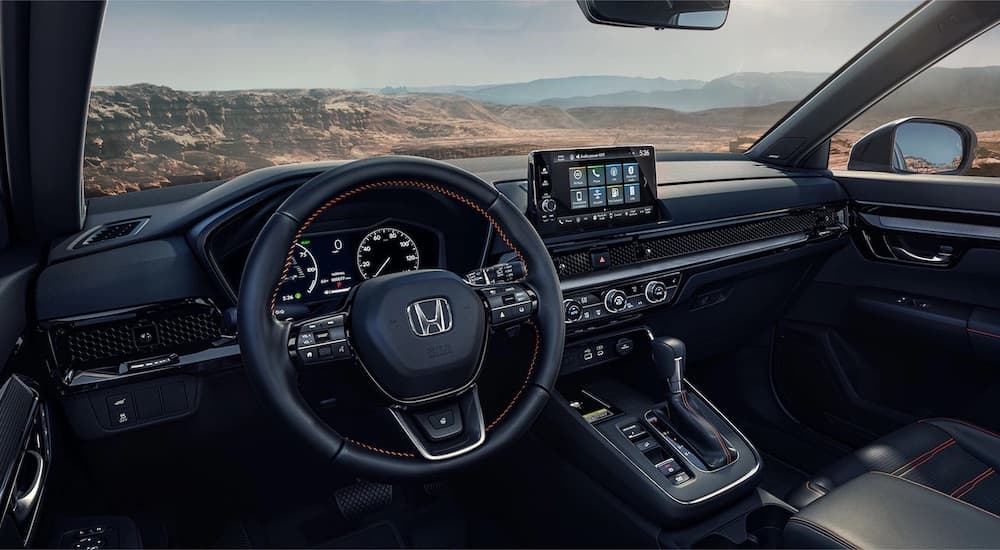When you set out to find a new or pre-owned Honda CR-V Hybrid for sale, routine maintenance is probably the last thing on your mind. It can be hard to picture future oil changes, tire rotations, and all the other maintenance-related tasks when you’re browsing shiny new crossovers in the showroom or taking a test drive behind the wheel of Honda’s best-selling hybrid, but these can be important factors to consider as you narrow down your choices. Most drivers are familiar with what to expect as far as recommended maintenance for a gas-powered car, truck, or SUV, but making the jump to a hybrid model can come with a little uncertainty. What do drivers need to know regarding recommended maintenance for their CR-V Hybrid or any of Honda’s other hybrid models? Let’s review some of the finer points of hybrid maintenance and examine how this new generation of electrically assisted vehicles differs from their predecessors.
The Hybrid Advantage
When you get right down to it, maintaining a hybrid vehicle isn’t that much different from a model that’s solely powered by a gas engine. There are some subtle differences when it comes to the hybrid’s high-voltage battery, generator, electric motor, and brakes, but by and large, the standard recommended maintenance schedule remains largely unchanged. These extra components might lead you to believe that a hybrid vehicle would be a little pricier in terms of maintenance, but that’s not necessarily the case. Many of the most important parts are covered by a comprehensive warranty, and thanks to the use of regenerative braking, hybrids can actually see some cost savings in terms of brake pad and rotor replacement. The CR-V’s electric motor also reduces wear on the gas engine thanks to the fact that it can handle 100 percent of the acceleration duties when moving at lower speeds.
From oil changes and tire rotations to fluid and filter replacements and more, the maintenance checklist for a hybrid vehicle should be familiar to any driver who’s managed to keep their gas-powered vehicles on the road successfully. When the odometer hits the 7,500-mile mark, drivers should check and replace their fluids, inspect the brakes, and rotate the tires. While some of these jobs can be handled by an experienced at-home mechanic, others will require a professional touch. If you want to keep your CR-V working at its best, it’s important to establish a relationship with a trusted local dealership or mechanic who can offer their expertise. These tasks, and a few other basic checks, should be repeated every 15,000 miles in accordance with the recommended maintenance schedule found in the CR-V’s owner’s manual, which will also outline other checks, replacements, and maintenance tasks that need to be performed every 30,000 miles. In some newer Honda models, the traditional recommended maintenance schedule has been replaced with a new digital alternative in the form of the Honda Maintenance Minder, which we’ll discuss next.

Honda Maintenance Minder
As today’s vehicles continue to evolve and improve, keeping up with your recommended maintenance tasks has become just a bit easier. While keeping up with your oil changes has traditionally involved digging through a glove box full of invoices or referencing the little sticker they slap on your windshield after each visit, Honda has simplified the process with its Maintenance Minder technology. This handy system displays maintenance-related alerts on the driver information interface located on the CR-V’s gauge cluster and ensures drivers won’t neglect vital tasks like oil changes, fluid replacements, and tire rotations.
When the system detects that the CR-V’s engine oil life is at 15 percent or lower, it’ll give you a little reminder every time you go to start the vehicle. The engine oil life can also be monitored at any time by quickly scrolling through the steering wheel-mounted controls to provide drivers with real-time feedback. These sorts of engine oil life monitors aren’t exactly cutting-edge, but the Honda Maintenance Minder has a few other tricks up its sleeve that really up the convenience factor for drivers who have a tough time keeping up with routine maintenance. In addition to tracking oil life, the Maintenance Minder can display a series of alphanumeric codes related to everything from the brakes to the tires, filters, transmission fluid, spark plugs, coolant, and more. Drivers shouldn’t rely entirely on the Maintenance Minder system, but it serves as an important form of backup that’ll help keep you up-to-date on crucial maintenance tasks.
Hybrid-Specific Systems
Of course, hybrids have a secondary electric drive system in addition to the traditional gas engine. It is relatively maintenance-free, but let’s take a closer look at the electric side of the hybrid equation.
Battery
Most drivers know that a vehicle’s 12-volt battery needs to be replaced every three to five years, but what about the additional high-voltage units that help power vehicles like the CR-V, Accord, and Civic Hybrids? These lithium-ion batteries are a marvel of modern engineering, employing a lightweight design that packs a ton of power while allowing hybrid and all-electric vehicles to significantly outpace their gas-powered counterparts in terms of efficiency and range. They also boast some impressive longevity and are typically rated to last for the life of the vehicle. The Honda CR-V is designed with a 1.1-kWh lithium-ion battery pack that, in collaboration with the 2.0L I-4 engine, allows the crossover to post an EPA-estimated 43 MPG city and 36 MPG highway.
The CR-V’s lithium-ion battery pack is the backbone of the SUV’s hybrid system and carries a generous warranty to reflect this importance. As is the case with all Honda hybrids, the CR-V’s battery is covered by an eight-year/100,000-mile warranty that offers valuable peace of mind for budget-conscious drivers. The high-voltage battery doesn’t require much in the way of maintenance and can be easily tracked through the CR-V’s Power Flow Monitor screen on the driver information interface, but there are a few tips and tricks that’ll help to keep it in tip-top shape. Like all batteries, the CR-V’s lithium-ion pack gradually loses power over time, especially when the vehicle isn’t being driven regularly. In order to guarantee consistent performance, try to drive the vehicle for at least 30 minutes every three months. That shouldn’t be too difficult for the average motorist, but if you’re regularly switching between seasonal vehicles, keeping the hybrid in the rotation is important. If you encounter some difficulties or suspect that your battery is starting to lose its edge, a mechanic and dealership can quickly check the hybrid battery system as part of a routine maintenance visit.

Generator and Electric Motor
The lithium-ion battery is just one part of the equation in today’s hybrid vehicles. The generator and electric motors also play a major role, starting the gas engine and converting its mechanical energy into electrical energy that can drive the electric motors and recharge the battery. In addition to turning the wheels to move the car, the CR-V’s electric motors also serve as small generators as part of the regenerative braking process, essentially operating in reverse to capture a portion of the electrical energy that would otherwise be lost every time you step on the brake pedal. Keeping the generator and electric motors in good working order is essential to the CR-V’s performance and efficiency, but the high-voltage nature of the hybrid system makes the DIY approach a bit difficult. The lithium-ion battery operates at more than 260 volts, which means it’s 20 times more powerful than the 12-volt battery that most drivers are familiar with. High voltage means high danger, so we’d recommend staying well away from the CR-V hybrid system and leaving regular maintenance checks and repairs to the professionals.
Brakes
There’s no underestimating the importance of a good set of brakes when it comes to safely and effectively operating a vehicle. Worn-out brake pads and rotors present a real risk every time you hit the road, which means routine inspections and timely replacement should never be treated as an afterthought. While the pads and rotors on your typical vehicle usually need to be swapped out every 30,000 to 60,000 miles, hybrids are an entirely different story. Regenerative braking not only recharges a hybrid’s lithium-ion battery, it also drastically reduces the wear and tear on the braking system. It’s not unusual for a hybrid to go some 100,000 miles between brake pad and rotor changes, especially if you frequently rely on regenerative braking to bring the vehicle to a stop. CR-V drivers can even adjust the regenerative braking system to be more responsive, which can go a long way toward reducing the SUV’s lifetime maintenance costs. The pads and rotors are the same as on non-hybrid vehicles, so despite the longer life, the cost and procedure of replacement are similar.
Hybrid vehicles represent an exciting evolution in the world of personal transportation, but embracing a new powertrain can be a little intimidating for those who aren’t as experienced with the segment. New technology always brings new challenges, but it also offers new opportunities and, in the case of the Honda CR-V, some substantial cost savings in terms of efficiency and lifetime maintenance costs. Sure, you’ll need to keep an eye on the battery and have the electric motors and generator inspected at regular intervals, but when you consider the countless advantages of the hybrid approach, it’s a small price to pay. The Honda Maintenance Minder goes a long way towards simplifying the maintenance process, but ultimately it’s no replacement for the sort of detailed care that a vehicle will receive from a dealership or service center. If you’re mindful of the unique maintenance requirements of the Honda CR-V Hybrid, the SUV is sure to return the favor with countless miles of worry-free driving.

